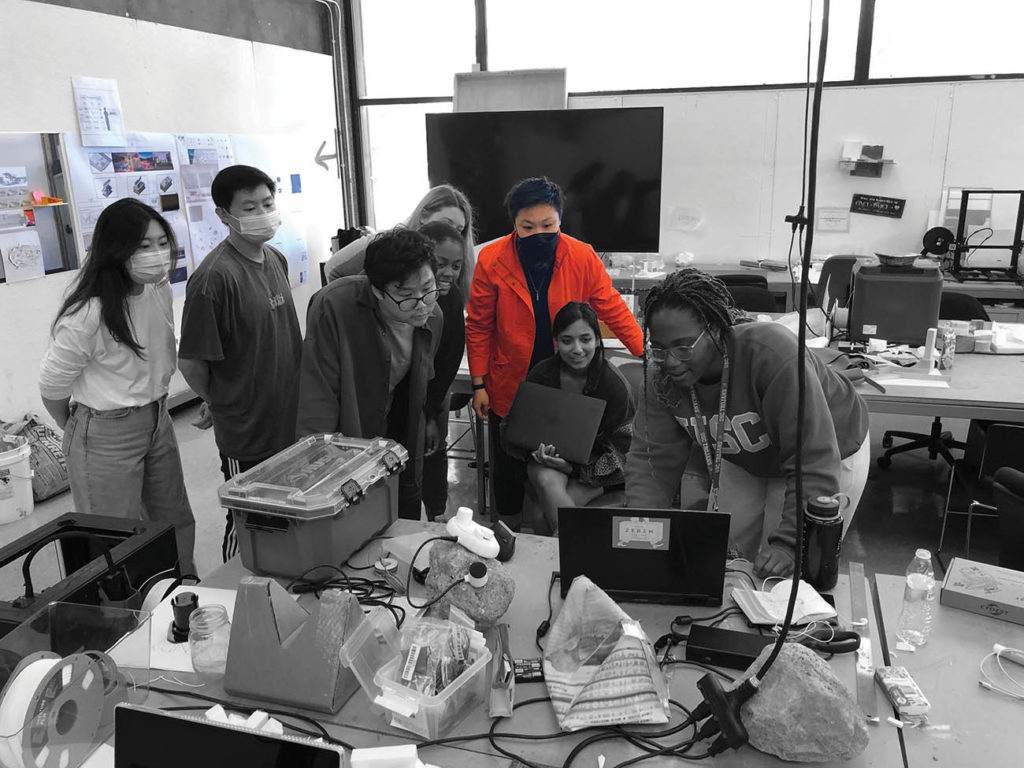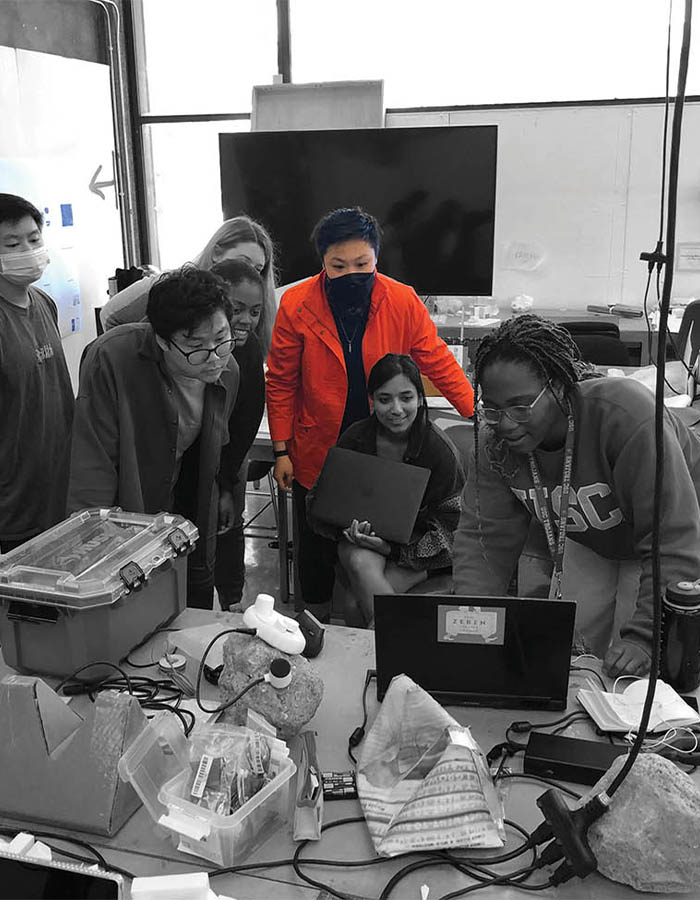Wendy W. Fok
June 15, 2022

Talking to Wendy W. Fok feels easy even though the myriad topics discussed are not. She has a way of meeting you where you are when giving her extensive insight and knowledge, breaking down complex issues into ‘byte-sized’ information. Aside from removing the marketing veil of trendy terms such as NFTs (non-fungible tokens) and seeing the utility of digital objects as they are, Wendy brings our attention to connecting the dots from data creation, distribution and storage to architecture, construction and real estate. A special appearance during the Zoom call by one of Wendy’s dogs was the (personal) cherry on top.
The process of creating data, e.g., whether designing a building or minting an NFT and its countless iterations, has a real impact on the environment—but not a topic looked at much because we are often concerned with the end product—such as the amount of energy used and the resultant carbon footprint; in what ways is such data then distributed and how it is eventually stored. With the digital/virtual world expanding amidst continuing physical development, we need to start designing anew more sustainably, by critically investigating our processes and in adapting infrastructures and support systems, that will ensure the future does not end up like the one in the Matrix movie.

THE IMPACT OF DATA CREATION, DISTRIBUTION & STORAGE ON AEC
DM: We’re doing this issue on new and emerging technologies in architecture, and we looked around to see if there was someone who had the expertise to speak about all of these things. We chanced upon your pavilion at the last Venice Architecture Biennale, where you spoke about digital structures, and you also had a focus on sustainability, which is why we wanted to talk to you about these topics.
WF: Yes, it’s a lot of the work that I’ve been researching on—it has probably been 10 years now or maybe a little bit longer. I just returned back from the MacDowell fellowship residency, where I stayed and worked on my manuscript for the past month. I was funded by the Ford Foundation on the opportunity, and I spent the residency to finish up a lot of my writing for digitalSTRUCTURES: Data and Urban Strategies of the Civic Future that’s coming out at the end of this year.


The book itself is touching upon larger interests on how data is being transferred, being used, and how architecture, engineering and construction or the AEC industry is looking at ways to either store it, or looking at how we are considering means of distributing data. So, one part of my research is:
When we have a lot of information—and that could be digital objects and/or digital media—how does that affect the way that we live in terms of storage, in terms of distribution, in terms of data centres?
There are two aspects to look at. One is how are we connected throughout the entire world with digital information and a lot of that megastructure discussion.
The second aspect, which I’m focusing on, is how do we live with data? That’s one of the biggest questions we have now. If there are ways to integrate the system into existing infrastructure or build-out or even furniture pieces, like floorboards, walls, Zip Walls, etc., how can we have a more sustainable system? I’m making my thesis students look at it at the University of Southern California (USC) architecture programme. And there’s a lot of discussion here.


One of the larger issues is that not a lot of people talk about it. And this is something that is going beyond how we’re applying this to the real world. How do we actually start as architects to think about this? Because we’re not going to live with less data—we’re just going to live with more. But if we’re going to build more data centres, then we’re decentralising the information so much that we don’t remember where it’s being stored.
Can we bring these decentralised systems into the physical and digital (phygital) spaces, and how would we integrate these systems of interior architecture and infrastructures into our day-to-day lives? For me, that’s a core issue that needs to be further investigated by designers and architects alike.
THE UTILITIES OF BLOCKCHAIN, NFTS FOR DESIGN & BUILD
DM: I watched one of your presentations on YouTube, where you showed an image of a milk tea. You were exploring what it meant to delay the gratification of having the physical object with you, and then creating something on top of the process to understand it better.
Is that one kind of application that encapsulates what’s going on with the metaverse, the virtual world and so on? It’s basically adding another layer of experience on top of what we already have, right? And creating value out of the process instead of the end product. Can you explain more about that?
WF: In terms of Everyday an Object project, it was a more of an exploration of digital objects in a storytelling manner for novel exploration. It literally uses a form of digital objects in a visual state to represent currency. The project was created for a non-profit fundraiser for Welcome to Chinatown—it works with Asian and Asian American Chinatowns to offer non-English speaking residents and business owners small grants for their livelihood. For instance, what if we no longer need to use dollar bills, Singapore dollars for example, and are instead able to use our digital objects as a form of exchange? Essentially, NFTs are enabling some users to do that with digital currency. Although this is fluctuating the economy and markets, because it is a very volatile currency, one of the larger discussions is, and my interest is, whether or not we could actually use any of these digital objects as a means of exchange.


Back to the barter system—we do something, we make something, and we could use that to purchase something else, right? You could write a poem, or a short clip of music, and then go to the supermarket and buy something with it. That’s enabling a formal exchange, like as a marketplace, a digital marketplace. Certain types of NFTs are enabling users to do that. That’s a very different discussion to, let’s say, how detrimental it is to the environment.
We model things in 3D—students, architects and industrial designers do this all the time—a lot of information and content that’s essentially wasted labour, invisible labour when you do multiple iterations for clients. What if those things could generate another way of formal exchange?
That’s really what I’m interested in with that project alone. But beyond that, the larger discussion and hype that goes around NFT projects is that the NFT community itself is formalising a more economic exchange with digital products. And that’s interesting because you’re not only using physical objects or physical currency as a form of exchange. It’s about potentials that interlink the concept that phygital objects cannot exist without the other.
The word meta or metaverse is not really a new term. It just has a renewed way of the current community embracing it. I think there needs to be a more critical lens to push the boundaries of how we can use crypto, but overall, if there’s a more sustainable (in terms of business and design) manner of engaging with the world of meta, then as architects and designers, we can bring more abilities to make the endeavour resilient.
[This is an excerpt. Subscribe to the digital edition or hardcopy to read the complete article.]

Wendy W. Fok, trained as an architect, is the creative director and technologist of WE-DESIGNS and New Territory. Fok is proficient in 3D modelling, innovative material research, design-build, augmented reality (AR) and mixed reality (XR) design. She co-edited AD Journal’s Digital Property: Open Source Architecture, which explores new views of authorship in the digital construction revolution. Aside from receiving various fellowships and awards, she holds a Doctor of Design from Harvard Graduate School of Design (GSD), obtained her Master of Architecture and Certification of Urban Policy/Planning from Princeton University, and a Bachelor of Arts in Architecture with a Concentration in Economics (Statistics) from Barnard College, Columbia University. Fok is a Visiting Professor at Pratt Institute’s School of Architecture, Teaching Fellow at the Harvard Law School, and Professor of Architecture at the University of Southern California.
RELATED: In Conversation | Next-Generation Technologies in Architectural Design

Read more stories from FuturArc 2Q 2022: New & Re-Emerging Architecture!

To read the complete article, get your hardcopy at our online shop/newsstands/major bookstores; subscribe to FuturArc or download the FuturArc App to read the issues!
Previously Published FuturArc Interview
Contact us at https://www.futurarc.com/contact-us for older interviews.

